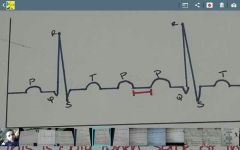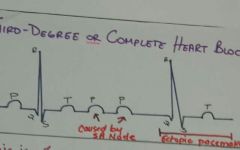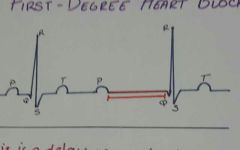![]()
![]()
![]()
Use LEFT and RIGHT arrow keys to navigate between flashcards;
Use UP and DOWN arrow keys to flip the card;
H to show hint;
A reads text to speech;
32 Cards in this Set
- Front
- Back
|
What factors affect flow through a tube such as a blood vessel?
|
Changes in the pressure gradients Resistances AKA Friction. The radius of the tube the length of the tube and the viscosity of the fluid in the tube. |
|
|
Hydro static pressure Driving pressure |
When a fluid is not moving the pressure is HSP The pressure that comes from the ventricles into the blood vessels during contraction |
|
|
According to Poiseulle's law, what factors contribute to resistance to blood flow? Which of these is the most important biologically?
|
The radius of the tube the length of the tube and the viscosity of the fluid in the tube.
Radius of the tube is most important biologically factor (Milkshake and skinny ass straw) |
|
|
What is the difference between flow rate and velocity
|
Flow Rate is the volume of blood that passes a given point in the system per unit time it is expressed in (L/per min) Velocity is the measure of how fast blood flows past a given point |
|
|
Compare and contrast cardiac muscle fibers (contractile/myocardial fibers) to skeletal muscle fibers (Hint: include size, EC-coupling, and where Ca2+ comes from in each cell-type)
|
Myocardial fibers are branched with a single Nucleus and they are attached by specialized junctions known as intercalated disk. Myocardial cells don't need any neuronal input the heart has auto-rhythmic cell EC Coupling contraction originates spontaneously in heart pacemakers cell spread through gap junctions T tubules larger in Myocardial cells branch into the myocardial cells Sarcoplasmic rectilium smaller in MC MC needs additional CA from ECF 10 percent |
|
|
layers of cardium and function (PEME) |
Pericardium Outer membrane protective covering that holds heart in place. Epicardium other side of the pericardium Myocardium The muscular tissue of the heart supports contraction and relaxation. Endocardium similar to the endothelial cells provides protection to valves and chambers |
|
|
action potentials in auto-rhythmic cardiac muscle cells
|
starts at -60 MV unstable so its called pacemaker potential 1 IF Funny channels open these channels are permeable to both K and NA. Na absorption happens at a faster rate than the diffusion of K (SLOW Depolarization) 2IF channels gradually clothes as cell becomes more postive 2bCA channels open causing the membrane to reach further depolarization (Rapid Depolarization) 3 K channels open (Slowly) Repolarizing cell |
|
|
Steps of the action potentials in contractile myocardial muscle fibers
|
0 NA entry through voltage gated channels
NA takes the cell away from its resting membrane potential of -90 MV makes it positive 1 Cell reaches +20 MV and Na Permability Decreases (STOP Leaking) 2and then K channels open allowing K to leave the cell and repolarzation to begin 2B The plateau phases is were repolarization is brief due to decrease in K permeability and increase in CA Permeability repole flattens out to this change in concentration gradients 3 Rapid Repolarization occurs when Roles of K and CA occur 4 Resting membrane potential |
|
|
pacemaker potential |
like resting membrane potential it just fluctuates |
|
|
Why do contractile myocardial cells (in contrast to skeletal muscle cells) not exhibit tetanus? Why is this advantageous?(Fig. 14.11)
|
they dont display tetanus due to the fact that that myocardial action potentials prevent sustained contraction this is importtant because cardiac muscle must relax between contractions so that the ventricles can feel with blood 253 explain |
|
|
vasoconstriction
|
the constriction of blood vessels, which increases blood pressure.
|
|
|
vasodilation |
the dilatation of blood vessels, which decreases blood pressure.
|
|
|
auscultation
|
is listening to the internal sounds of the body, usually using a stethoscope.
|
|
|
Systole and Diastole |
Systole is the contraction phase of the cardiac cycle
is the part of the cardiac cycle when the heart refills with blood following systole (contraction). Ventricular diastole is the period during which the ventricles are filling and relaxing, while atrial diastole is the period during which the atria are relaxing |
|
|
Tachycardia and bradychardia
|
Tachycardia is a faster than normal heart rate at rest. A healthy adult heart normally beats 60 to 100 times a minute when a person is at rest
abnormally slow heart action. |
|
|
Describe the structures of the conducting system in the heart, and location plus function
|
SA Node pacemaker of the heart Autorythmic cells (RA) Inter-nodal pathways -connects SA Node To AV node (RA) AV Node Autorythmic cells that send depolarization to ventricles. (Lower RA) Bundle of his spread depolarization to ventricles (Ventricular septum) Right and left branches spread depolarization to ventricles (VS) Purkinje Fibers (VS) |
|
|
conducting system in the heart, How do they give rise to contractions that occur first in the atria and then in the ventricles? Why is this important? (Fig.14.13 and especially Fig. 14.14)
|
Action potential or Depolarization Begins in Sinoatrial Node of the right atrium and spreads throughout the gap Junctions
Single reaches AV Node (Rapidly) through internodal pathways. Depolarization spreads (slowly) across atria and through the AV node. Depolarization moves rapidly through the Ventricular conducting system to apex of heart This is important because blood is pumped out of the ventricles at the opening at the top of Ventricle chambers if Electrical signals from the atria went directly to the ventricles the ventricles would start contracting at the top forcing blood downward were it would become trapped in the bottom of the ventricles |
|
|
What is the ECG? What is it actually measuring?
|
The electrocardiogram is measuring the summed electrical activity of all cells in the heart |
|
|
Describe the waves of the ECG and what portion of the cardiac cycle each wave corresponds to. What is a wave, segment, and interval
|
r |
|
|
EDV |
is the amount of blood in the ventricles just before systole
|
|
|
ESV |
is the volume of blood in a ventricle at the end of contraction, or systole, and the beginning of filling, or diastole
|
|
|
Define stroke Volume How to calculate stroke Volume |
Amount of blood ejected in left ventricle during one contraction. SV= EDV-ESV |
|
|
Define Ejection fraction how do you calculate it. |
A measurement of how much blood the left ventricle pumps out with each contraction.
EF= SV/EDV*100 |
|
|
What is cardiac output |
the volume of blood being pumped by the heart, per unit time
|
|
|
Equation for Cardiac Output |
SV*Heart rate 70ML * 75 BPM= 5250 Ml per min convert to Liters |
|
|
What is preload |
Preload refers to the stretch on the sarcomeres just prior to initiation of contraction (systole). The more blood there is in the chamber just prior to systolethe more the sarcomeres are stretched. The more they are stretched, the stronger is the contraction that occurs during systole which results in a higher stroke volume. |
|
|
What is after load |
After load refers to the forces that oppose ejection of blood out of the chamber the vessels can constrict or dilate, and thereby change the amount of total resistance to blood flow. This resistance influences after load. Under normal conditions, the heart does not eject all of its contents. raising afterload decreases SV, and lowering afterload increases SV
|
|
|
How do heart rate and stroke volume affect cardiac output
|
Raising the Heart Rate or stroke volume will result in an Increased Cardiac out put.
|
|

What condition of the heart is this (The little red line is important ) |
Second degree heart block some of the P waves reach the ventricles less QRS Complex occur |
|

3rd Degree heart block |
electrical from the SA node are noting making it to the ventricles no Action potentials conduct through the Av Node |
|

First degree heart black |
Delay in p- r segment |
|
|
|
|

